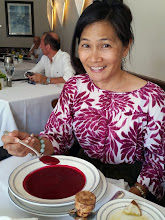Dylan, who by now expects the possibility of soup as a main course when dining with me, accompanied me to El Rocoto, a local favorite of fans of South American cuisine. Those of us who grew up eating the Mexican food of Southern California are always surprised by the inclusion of different ingredients in what we consider "traditional" dishes: saffron- infused masa for tamales, ceviche garnished with sweet potatoes and corn, walnut sauce.

Traditional Peruvian tamale, with chicken and egg mosaic and colorful garnish
Although most restaurants treat soup as merely a prelude, at El Rocoto it is an integral part of a meal at El Rocoto, as listed on the menu under "Soul Warmers." I chose parihuela salvaje, a lightly spicy brew of snow crab, shrimp, fish, mussels, squid, and octopus. Dylan ordered the chupe de camarone, which despite sounding like something you shout out the window when getting cut off on the 110, was surprisingly mild in flavor, although loaded with a cornucopia of ingredients - including corn.

When I was a kid, soup was something that you ate when you were under the weather. Not so at El Rocoto, where you need to have all of your faculties present to partake of their hearty crustacean and mollusk-laden soups. By this I mean that you need to be able to use knife, fork, hammer, tongs, or blowtorch in order to extract the meat from claws and shells.

The right tool for the job... might still be in the garage. But we made do.
While Dylan is more handi-capable than most TABs I know - I just learned that this means "temporarily able-bodied"- his motor skills cannot easily accommodate a bowl full of crab legs and mussels on the half shell due to cerebral palsy. So I have come to anticipate certain tasks when dining with him such as cutting long strands of pasta into manageable lengths or large portions of meat into bite-size pieces.
I grew up fearing no fish and learned from my parents - who served boiled crabs and lobster thermidor as if they were meatloaf - how to take dismantle any shellfish in a relatively tidy manner. So I proceeded to use everything from the flatware on the table to my tiny Swiss army knife to extricate the sweet and savory flesh from its casings.
The shrimp chowder had among many other things, a fried egg, sunny-side up, on top of it. It had a full and satisfying sea-like flavor, very creamy and potatoe-y, with a surprising green herbal finish. Mine was more like a cioppino, very tomato-esque and spicy. My parihuela was full of snow crab legs, octopus, mussels, and squid.

Who you calling a shrimp?
While each serving is enough for three or four people, we tried bravely to make a dent in our respective bowls. We quickly surpassed the emergency supply of extra napkins that were thoughtfully tucked in anticipation underneath our bowls and had to ask for even more napkins to keep ourselves and the table presentable.

The aftermath. No clean napkin left behind.
Later, I was struck by the irony of humans who may not have the full use of their hands eating creatures who before they were dropped into a kettle of hot soup, once did. Which led me back to Seiji's admonition to my sister and I about eating shark fin soup.
The very food chain embodies the Orwellian fact that "some animals are more equal than others." This raises the question: If four legs are good and two are better, then what does ten get you?






No comments:
Post a Comment